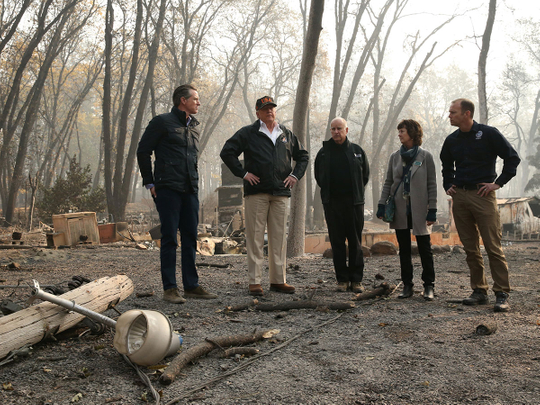
Washington, D.C.: US President Donald Trump has repeatedly blamed California’s forest management for the huge wildfires burning there, one of which has left at least 76 dead and become the most destructive in state history.
And even though experts called his criticism unjustified, this weekend he continued in that vein, suggesting that California should take lessons from Finland, a country with 23 million hectares of forests but comparatively few forest fires.
“You look at other countries where they do it differently and it’s a whole different story,” Trump said at a news conference in Paradise, California, on Saturday. “I was with the president of Finland and he said: ‘We have a much different — we’re a forest nation.’ He called it a forest nation, and they spent a lot of time on raking and cleaning and doing things. And they don’t have any problem.”
Trump added that when Finland does have forest fires, they are “a very small problem.”
But as with his earlier comments about forest management in California, experts said the president’s remarks were misleading.
The Finns don’t rake
Raking for leaves and needles is not a normal feature of Finnish fire prevention, according to Rami Ruuska, a forest fires expert at the Finnish Interior Ministry. Instead, Finns focus on removing dead trees from the forest floor — where possible.
“Of course, we have a big country and we can’t do it everywhere,” Ruuska said.
President Sauli Niinisto of Finland said, in an interview published Sunday in a Finnish newspaper, that in a brief conversation in Paris on November 11, he had explained the virtues of Finnish forest management to Trump. But he didn’t recall mentioning raking.
The secret to the Finns’ forest management system lies instead in its early warning system, aerial surveillance system and network of forest roads, said Professor Henrik Lindberg, a forest fires researcher at the Hame University of Applied Sciences, a college in southern Finland.
At times of high incendiary risk, Finnish authorities are highly effective at delivering warnings across most forms of media, Lindberg said.
Local aviation clubs are paid to fly over the most threatened areas of forest, increasing the likelihood fires will be spotted before they spiral out of control.
“The ignition probability is about the same as in Sweden, but they’re caught quicker,” Lindberg said.
And timber and paper companies have built an extensive network of roads through Finland’s forests. Built primarily to make the landscape more accessible for logging, they also slow down the path of a fire — and allow fire brigades to reach the flames faster.
“Almost all Finland is covered by this forest road network, so of course it’s easier to get nearer to the forest fires using fire trucks,” Ruuska said.
Finland is much colder than California
Temperatures in Finland, part of which lies within the Arctic Circle, can drop below minus 45 degrees Celsius. Even in August, the temperature is usually low.
The incendiary risk is therefore much lower for most of the year in Finland than in California, where high temperatures, dry air and frequent wind make wildfires far more likely.
“It’s not a good comparison,” Ruuska said. “We have a half-metre of snow during winter, so it’s quite natural that we don’t have any fires over the winter, and our autumn is quite wet.”
The trees aren’t the same
Finnish forests are mainly filled with tall boreal trees — pine, spruce and birch — whereas much of Californian vegetation consists of lower-lying chaparral shrub land and small trees, which are more prone to catching fire.
“The whole comparison is a bit wild,” said Lindberg, who suggested that it would be better to study methods in Mediterranean Europe, where forests are more like those in California.
Finland is not fire-free.
Despite its effective fire-prevention system, Finland still experiences forest fires: Around 1,000 hectares of trees have burned down this year, the highest annual total since 2006, Lindberg said.
But the damage was still much less severe than in neighbouring Sweden, where 25,000 hectares were affected.
“We’re doing something right,” Ruuska said. “But we also have good luck.”












